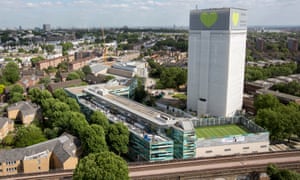Evacuating Grenfell Tower was “impossible” because insufficient firefighters and equipment had been deployed by the time the flames were at the top of the building, the first fire brigade commander on the scene has told the public inquiry into the disaster.
Michael Dowden, a firefighter for 14 years and watch manager at North Kensington fire station, said that although the flames had risen to the top of the 24-storey tower by just before 1.30am on 14 June 2017, the instruction to residents to stay put could not be reversed as there were just six fire engines on the scene and limited breathing apparatus kits.
He said he did not give any thought to changing the “stay put” instruction at the time of the fire, which killed 72 people, but has since reflected it could not have been done.
The “stay put” policy was based around the building being constructed in a way to keep fires from breaking out of individual flats. It failed at Grenfell by 1.26am, the inquiry heard previously from expert fire engineer, Dr Barbara Lane. Residents were only told to try to evacuate after 2.47am. Many who were told to stay in their flats never got out.
“For me to facilitate and change a stay-put policy to a full evacuation was impossible,” Dowden said. “I didn’t have the resource at that time. We’re looking at 20 floors above the fire floor with just six fire engines in attendance, one central staircase. I just don’t know how that could be done with the resources we had in attendance at that moment in time.”
Dowden also told the inquiry that under London Fire Brigade guidance he was too junior to be left in charge of the fire as it raged out of control, that he felt out of his depth and was “consumed by sensory overload”.
He was the incident commander until around 1.50am, and by 1.28am he had ordered 15 fire engines to the scene. Fire officers of his rank are normally only in charge of fires requiring four pumps, the inquiry heard.
“I wouldn’t generally be in charge of a six-pump fire or an eight pump fire if a more senior officer was in attendance … The way that fire developed meant I was in charge for longer than usual.”
During his second day of evidence, Dowden had to take frequent breaks as he was asked to recall taking charge of a fire, the scale of which he had never seen before. At one point, having seen a video of the tower and onlookers shouting at the residents to get out, he had to ask for the hearing to be paused and wiped tears from his eyes.
“I started to become very consumed in terms of what was happening in front of me,” he said under questioning from Richard Millett QC, counsel to the inquiry. “I think the way it was increasing and developing, that I’ve never seen anything like that before.”
He said he didn’t know the tower was wrapped in combustible cladding and could not understand why it was “sparking and spitting” as it burned.
“I knew there was a BA team (firefighters in breathing apparatus) within [flat 16] and I couldn’t understand why that fire wasn’t being suppressed,” Dowden said. “They were tackling a compartment fire which they were making good progress on and from what I would see on the outside it was a different story.”
“I did feel uncomfortable, out of my comfort zone because I didn’t have any previous experience to fall back on in terms of ... the way it was behaving and reacting.”
The inquiry heard that other firefighters repeatedly used their radios to urge Dowden to call for extra resources.
The inquiry was shown footage taken at around 1.12am on 14 June last year in which another firefighter could be heard shouting to Dowden: “Mike, Mike, make it six now, make it six now,” referring to the need for more fire engines.
By 1.28am fire fighters inside the building were also demanding reinforcements with breathing apparatus “because there were now numerous calls for rescues on many floors.”

Dowden repeatedly said he did not recall these interventions, but said parts of his memory from the night were missing.
He also described how firefighters were unable to get water to the top floors of the tower, because the building was designed with an firefighting infrastructure that meant that above 50 metres the “water supply would be almost non-existent”.
He described how the system of pipes running up the building to fight fires – known as dry risers – were unable to cope with the multi-storey fire.
Dowden and his team plugged their hoses into two dry risers – one on the fourth floor and another on the third floor. This allowed them to blast 230 litres of water a minute with each hose, well within the fire brigade’s capability of providing 1,500 litres a minute to the fire.
But the fire quickly spread up and around the facades. Millett asked Dowden if he could have plugged hoses into every outlet to battle fires as they spread to other flats.
“That’s an almost impossible task … the dry riser is not designed to do that,” he said.
The inquiry continues.